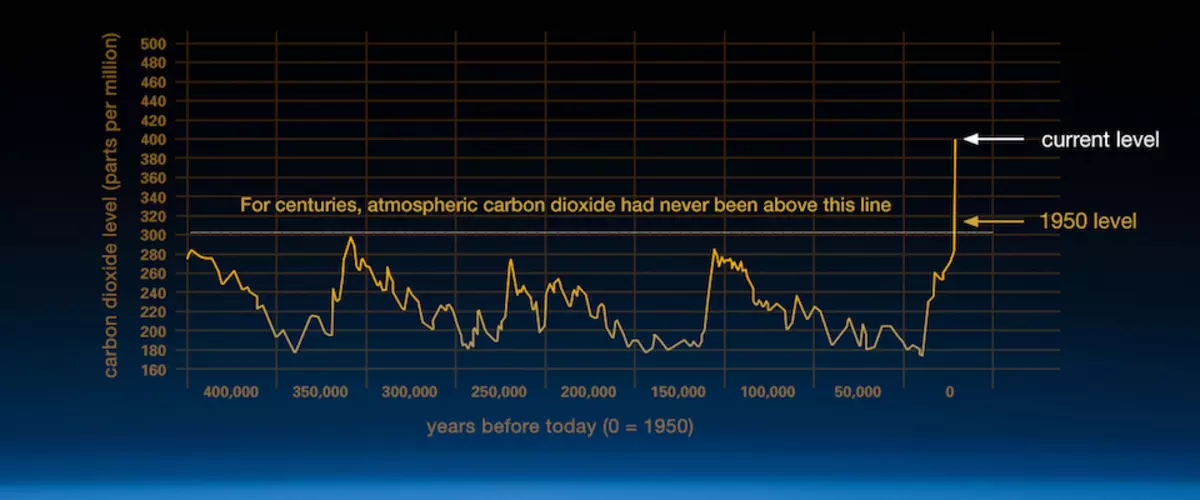Lateral Reading-Model-Evidence Link Diagrams (LR-MEL) Project
The purpose of our project is to promote students' civic and scientific evaluations of sources and alternative claims when confronted with controversial and/or complex socioscientific issues in the Earth and environmental sciences. We do this by integrating English Language Arts (ELA) and social studies classrooms—focused on source evaluation—with science classrooms—focused on evaluating connections between lines of evidence and alternative explanatory claims. We are developing, implementing, and testing complementary Lateral Reading (LR) and Model-Evidence Link (MEL) scaffolds that include instructional materials and methods in both social studies and science classrooms. Issues students explore range from climate change and extreme weather to freshwater availability and food security along with many others.
Previous
Next

Climate Change: Increases in atmospheric carbon dioxide since the Industrial Revolution
![[reuse info]](/images/information_16.png)
Provenance: Vostok ice core data/J.R. Petit et al.; NOAA Mauna Loa CO2 record
Reuse: This item is in the public domain and maybe reused freely without restriction.

Fracking
![[reuse info]](/images/information_16.png)
Provenance: EPA
Reuse: This item is in the public domain and maybe reused freely without restriction.

Wetlands
![[reuse info]](/images/information_16.png)
Provenance: Eric Vance, EPA
Reuse: This item is in the public domain and maybe reused freely without restriction.

Moon Formation
![[reuse info]](/images/information_16.png)
Provenance: NASA
Reuse: This item is in the public domain and maybe reused freely without restriction.

Extreme Weather
![[reuse info]](/images/information_16.png)
Provenance: Centers for Disease Control and Prevention
Reuse: This item is in the public domain and maybe reused freely without restriction.

Fossils
![[reuse info]](/images/information_16.png)
Provenance: Ohio Department of Natural Resources
Reuse: This item is in the public domain and maybe reused freely without restriction.

Freshwater
![[reuse info]](/images/information_16.png)
Provenance: National Estuarine Research Reserve System
Reuse: This item is in the public domain and maybe reused freely without restriction.

Origins of the Universe
![[reuse info]](/images/information_16.png)
Provenance: NASA, ESA, and M. Montes (University of New South Wales)
Reuse: This item is in the public domain and maybe reused freely without restriction.
Project Overview
The Lateral Reading-Model-Evidence Link Diagrams (LR-MEL) project is investigating how deeper evaluations might promote changes in students' epistemic judgments, including source trustworthiness, and claim plausibility, toward a more civically-minded and scientific stance. We are also developing and implementing three-day summer institutes and follow-on professional development to help middle and high school ELA, social studies, and science teacher teams use LR (in ELA and social studies) and MEL (in science) scaffolds to facilitate students' critical-analytic thinking, evidence-based reasoning, and core disciplinary knowledge.
Lateral Reading - Source Evaluation

Extreme Weather Lateral Reading Source 1
![[creative commons]](/images/creativecommons_16.png)
Provenance: Science Learning Research Group, UMD
Reuse: This item is offered under a Creative Commons Attribution-NonCommercial-ShareAlike license http://creativecommons.org/licenses/by-nc-sa/3.0/ You may reuse this item for non-commercial purposes as long as you provide attribution and offer any derivative works under a similar license.

Extreme Weather Lateral Reading Source 2
![[creative commons]](/images/creativecommons_16.png)
Provenance: Science Learning Research Group, UMD
Reuse: This item is offered under a Creative Commons Attribution-NonCommercial-ShareAlike license http://creativecommons.org/licenses/by-nc-sa/3.0/ You may reuse this item for non-commercial purposes as long as you provide attribution and offer any derivative works under a similar license.
Model-Evidence Link - Evaluating Connections Between Lines of Evidence and Alternative Explanatory Claims

Extreme Weather Introduction
![[creative commons]](/images/creativecommons_16.png)
Provenance: Science Learning Research Group, UMD
Reuse: This item is offered under a Creative Commons Attribution-NonCommercial-ShareAlike license http://creativecommons.org/licenses/by-nc-sa/3.0/ You may reuse this item for non-commercial purposes as long as you provide attribution and offer any derivative works under a similar license.

Extreme Weather pcMEL diagram
![[creative commons]](/images/creativecommons_16.png)
Provenance: Science Learning Research Group, UMD
Reuse: This item is offered under a Creative Commons Attribution-NonCommercial-ShareAlike license http://creativecommons.org/licenses/by-nc-sa/3.0/ You may reuse this item for non-commercial purposes as long as you provide attribution and offer any derivative works under a similar license.
Project Support
The Lateral Reading-Model-Evidence Link Diagrams project is supported in part by the NSF under Grant Nos. DRL-2201012, DRL-2346657, DRL-2201015, DRL-2201016, DRL-2201017, and DRL-2201018. Previous support came from Grant Nos. DRL-2201013, DRL-2027376, DRL-1721041, and DRL-1316057. Any opinions, findings, conclusions, or recommendations expressed are those of the authors and do not necessarily reflect the NSF's views.


![[reuse info]](/images/information_16.png)








![[creative commons]](/images/creativecommons_16.png)


